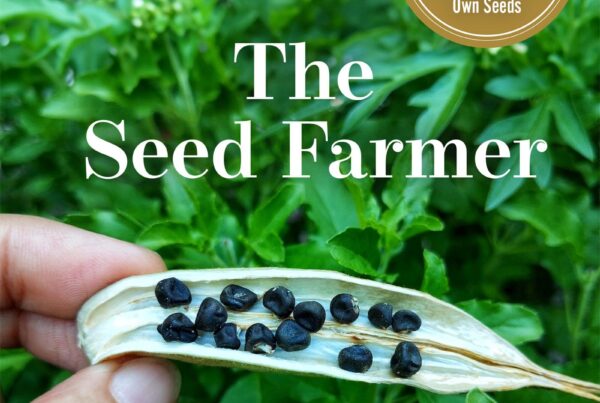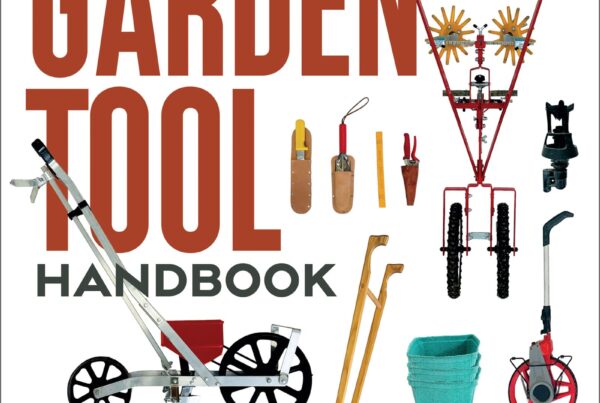The Home-Scale Forest Garden: How to Plan, Plant and Tend a Resilient Edible Landscape, Dani Baker, Chelsea Green Publishing, May 2022. 325 pages, 8″ x 10″, full color photos, $34.95.
Book Review by Pam Dawling
The Home-Scale Forest Garden provides plenty of detailed information to help others succeed in creating small-scale resilient low maintenance edible havens. Dani Baker started creating her forest gardens over ten years ago on Wellesley Island in the St Lawrence River, between New York and Canada (zone 4). She and her partner raise certified organic produce, grass-fed beef and goats. She tells of her successes and failures, and the strategies she developed to overcome the challenges of very wet soil, deer attacks, climate chaos and more.
The first third of this book covers planning and planting a small forest garden. The main part of the book is a directory of plants, to help you choose plants for every level, (or “story” as the permaculturists call them). Everything from canopy trees to vines and fungi and the full range in between. The last part of the book helps with creating compatible plant groupings. Appendices give a table of nutrient accumulator plants and which nutrients each accumulates; a chart of blooming and harvest times, and a calendar of monthly maintenance tasks.
Forest gardens are modeled after nature, rather than farms: low maintenance, mixed plantings, permanent soil coverage, continuously increasing carbon sequestration. This kind of garden is regenerative: the ecological state improves each year as humus builds up. Yes, some of the plants take a long time to reach maturity and provide harvest. But herbs, berries and perennial vegetables can be harvested from your first year.
Dani and her partner David Belding bought 102 acres in the northern US, close to the Canadian border, when they retired from full-time careers, thinking to dabble in landscaping and keep a couple of horses, not to farm. The land was formerly a dairy farm, more recently hay ground with a small vegetable market farm. In their first spring, they planted a small vegetable garden, as Dani had done as a teenager. They sold all they grew, so the next year they doubled the size of the garden and bought two pigs. Retirement wasn’t boring! The garden increased to ¾ ac (0.3 ha) and the farm gained chickens, ducks, goats, beef cows and more pigs. Dani focused on the gardens, David on the livestock.
In their seventh year, Dani attended a permaculture workshop, inspiring her to create her own forest garden, fenced to keep the livestock and wild predators out. They did not want to reduce the pasture, so they chose a scrubby 100 x 200’ (30 x 61 m) area near the road. Your forest garden might be as small as 25 ft2 (2.3 m2).
They cleared the brush and designed a garden including an events space, a pond with a bridge, a patio and various plantings. Quite a bit of hardscaping (paths) was involved, meaning that long-term planning was important – no tilling everything up in November anymore! Three years later they doubled the size of their forest garden, and also expanded into the adjacent woodland, to plant under existing trees. This wooded area had standing water a lot of the year, so Dani created hügelkultur mounds, which are fully explained in chapter 4. Basically they are piles of wood trimmings that become raised beds.
For those already thinking they would miss tomatoes too much to do this, be reassured that both are possible for people with enough land. Dani has an area of market garden beds near the house. It’s also possible to integrate some annual crops within a forest garden in the early years when trees are small and plenty of light can reach the lower levels of plants. Ultimately the two kinds of gardens do better apart, as their needs and cultivation methods are different.
This is a book applying various methods, including some found in permaculture books, but it’s not a permaculture theory book, and Dani does not consider herself a permaculturist. There are none of those diagrams of the concepts of guilds, swales and redundancy in functions. You don’t have to be a believer to find value in these practices.
The six principles the author values and uses are:
- “maximizing diversity,
- maximizing solar absorption,
- maximizing water conservation
- designing for sustainability,
- building-in redundancy and
- minimizing human labor into the future.”
Her hedges and ground cover areas all have diverse species, and you can read which ones. By including wide paths and a patio area, Dani has created lots of edges allowing sunlight in.
Using all the vertical space increases the plants absorbing the sunlight. The seven plant levels include
- the overstory of trees to 30′ (9 m) or more
- the understory of fruit, nut and other short trees, 10-30′ (3-9 m) tall
- the shrub layer of berry bushes and other plants, 3-12′ (1-3.5 m) tall
- the herbaceous layer of perennials that die back and regrow annually, 2-10′ (60 cm-3 m) tall
- the ground cover layer close to the soil, including strawberries and leguminous cover crops
- the root layer of plants with edible roots, such as sunchokes
- the vining layer, with height depending on the available supports
A fungus layer can be added, but fungi aren’t plants, so you might consider them off-list.
Those creating very small forest gardens, even in a container, will have to select some layers and not others.
To maximize water conservation, create a lot of leaf canopy, keep the soil covered, choose appropriate plants, collect rainwater and runoff and increase water-absorbing mulches. At the beginning, you can cover the soil with wood chips, improving conditions both immediately and longer-term. Notice where water collects on your land and match water-loving plants with damp locations. Ponds can collect and store water, to be used as needed for watering plants, as well as increasing the habitat for more species of small and larger creatures.
Design so that you do not usually have to actively water plants–the goal is a self-sustaining garden. Be sure to include nitrogen-fixing plants, some deep-rooting plants that accumulate nutrients, some that attract beneficial insects and some “aromatic pest confusers” to make pests unwelcome.
The concept of redundancy is to provide multiple ways a need can be met, (and multiple needs met by any one function). This increases sustainability and reduces the chance of the garden failing. Water can be provided by rain, ponds and a hose. Ponds provide other functions too, increasing the network of support.
All of the above contribute to reducing future human labor, which is a fine goal for anyone, but especially those creating gardens during their retirement years. Setting up a forest garden and getting it firmly established can be quite a lot of work, depending on the scale. After that, it will provide for you, and the rest of the ecosystem.
It is very important to plan your forest garden before planting anything, or making any changes to the space. You are creating long-term changes, not an annual garden that will be tilled up for a fresh start every year. Not all your plans will work out as expected, but not to worry: those who have a plan are best-placed to understand when and even how to make a change. Dani has examples, including how the dog changed the access through the hügelkultur area.
Part of your plan might be to try out plants that haven’t previously thrived in your climate. You can do this by finding the best microclimate in your garden for these crops, and improving those microclimates to suit the crops better. You can experiment on a small scale somewhere else on your land that has a suitable microclimate, to see if it will work. Assuming you don’t have huge financial resources, you’ll want to mostly grow plants you know will do well. Nut trees take a long time to provide a harvest, and who knows what the climate will be like by then? You might rather stick with berry bushes.
The first practical step, after dreaming, is to closely observe the land you plan to use, throughout every season and every type of weather. Pay attention to soil types, drainage, slopes, shade, microclimates, shelter or not from prevailing winds. Make a sketch of the various areas within your site and indicate the flows of water and wind, the sun and shade. Check the USDA winter-hardiness zone and soil types (ask your Extension agent). Dig holes after rain to assess how quickly the soil drains, and note where the rivulets run. Decide if you need to install culverts or drains. Decide if you want to include a pond, and if so, where would be the best spot.
Next, make a scale map, with accurate measurements of lengths in all directions. Mark existing trees, stumps, shrubs, slopes, rock outcroppings, flow of surface water and any human-built structures. The book explains how to triangulate distances from two known points. Add contour lines. Check the map against the territory, ensuring its accuracy.
With an accurate map you can start to pencil in your ideas, balancing all the factors already discussed. Site the big trees, ensuring you give them adequate space. Fill in with the next tallest plants, and work down by height. Make sure your taller plants won’t shade smaller ones that need good light, or ponds that benefit from solar warming. Site windbreaks where you need them, and plants that tolerate wet soil in the dampest spots.
Dani offers planning tips, like cutting discs of paper for the large trees, and moving them around your map to get the best configuration. She quotes from Martin Crawford, who wrote Creating a Forest Garden. He suggests:
- Choose fast-growing species that will serve their ultimate purpose
- Plant trees and shrubs close enough to create a continuous dense mass when mature
- For windbreaks, plant a line of trees perpendicular to the direction of the wind, then plant smaller bushier plants downwind
- Don’t expect other plants to thrive close to a windbreak, because roots compete
- Reduce weed competition to speed forest development
Dani chose hügelkultur beds for the places that often had standing water. It was a good solution for making raised beds that would keep the plants’ roots out of the water. You will need to accumulate lots of resource materials, (unless you are making a tiny forest garden). Where possible, get the heavy piles of organic matter delivered to the high point of the land, so you only ever move it downhill!
If you need heavy equipment on the land to construct walkways, ponds, bridges, gathering areas, or install culverts, do all this before any planting. Next, do any slow-change techniques like sheet mulching to kill weeds, or grazing, or rooting with pigs (who love quack grass). Land prep before planting is explained: build raised beds, make hügelkultur mounds on a base of dead logs and branches, build swales and give them an initial planting of annual vegetables to provide roots to stabilize the mound until time for a permanent planting, and how to frost seed. Implement your deer and livestock exclusion plan, before planting a single perennial. Later, consider adding bird and bat boxes and insect hotels.
Planting large perennials is different from dealing with annual vegetables, so be guided by this experienced author. Make yourself a nursery in a separate, shady area, where you can heel-in trees and shrubs that arrive before you are ready to plant them, store “extras” and where you can propagate from plants you already have.
Here in the book you’ll find step-by-step instructions for planting bare-root trees and shrubs in the dormant season. For perspective, there is a photo of a large number of metal nametags from perennial plants that failed in Dani’s forest garden! Some failures stem from poor decisions by the gardener, others from mislabeling by the seller, or a poor or damaged specimen, or injury in transit, or bad luck (sometimes known as insufficient or faulty information). There are also instructions for planting containerized trees, transplanting, pruning, fruit-thinning, weeding and watering. And dealing with pests. Wire trunk guards can protect young woody plants from girdling by rodents, which can kill the plant.
Once you have a certain woody plant in your garden, you can propagate from that to provide more. For berry bushes, this might only add one or two years before the new plant fruits too, getting good value from your initial purchase. The book explains layering, hardwood cuttings, division and seed.
In Part 2 you can browse and select plants that seem a good fit for your forest garden. The section on nut and fruit trees explains grafted trees, “southwest injury” where bark splits in spring due to expansion and contraction of the trunk on sunny south-facing afternoons, only to get very cold at night. This is why tree trunks are sometimes painted white. Chilling periods are explained: a minimum period of cold temperatures required during dormancy for successful fruiting. Allow for global heating when you decide which fruit trees to buy!
In the plant directory, each of the descriptions includes a summary of the plant’s native range, mature height, width of canopy, soil conditions, sunlight needs, and hardiness range. A system of icons indicates some of the key functions or benefits that plant provides. Dani adds some notes in her personal observations. These sidebars include things that went wrong; extra benefits and how to take advantage of them (wild groundcovers); extra needs (such as cross-pollination, stratification and scarification) and how to provide for them; or when to forego them (blueberries, because they require acid soil); practices that can work even if you expect them to fail (transplanting shrubs in the fall in zone 4, planting shrubs with fine fibrous roots in dry locations); particular pests (raspberry vine borer, plum curculio);
There are 13 tall trees, 21 shorter trees, 27 shrubs, 38 herbaceous plants, 16 ground covers, each with a beautiful photo. Each section has some species you will likely be familiar with and some unusual ones, such as Korean nut pine, hazelbert, shipova, buffaloberry, New Jersey tea, Good King Henry, saffron crocus, water celery and cinnamon vine (air potato).
The chapter on successful groupings of varied plants will give you plenty of ideas, and tips for calculating how to include enough nitrogen-fixing plants to supply all the other plants in your garden. With plants for pollinators, rather than calculating, just go for diversity and spanning the growing season so you have something in flower all the time. Plant elderberries on the edge nearest your potato plants and they will attract beneficial wasps that parasitize Colorado potato beetles. Plant groupings are suggested for sites in full sun or partial shade. There are tips for planting orchard rows and hedge-lines with shrubs and smaller plants in between the biggest trees. You can even save time and plant a (carefully chosen!) group of nine plants in one hole!
If you become enchanted by the ideas and the photos in this book, you can start to make a plan, and maps, and a plant list, and turn your dream into reality. Even if you only have a large planter on a patio.







